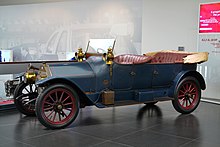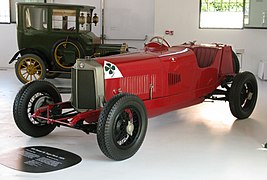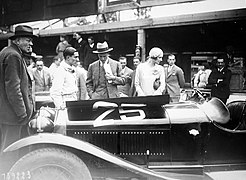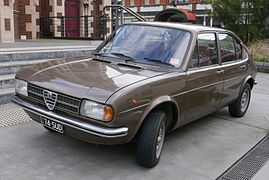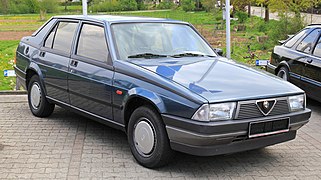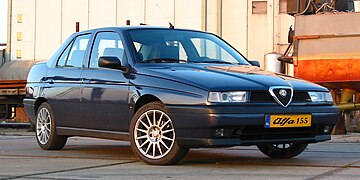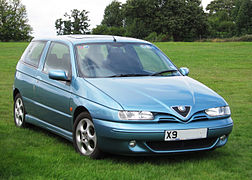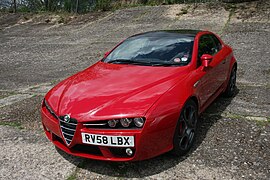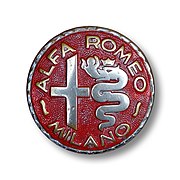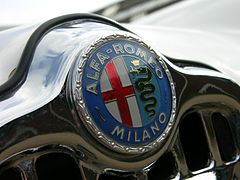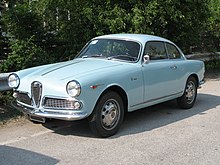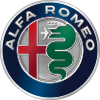Alfa Romeo
| Alfa Romeo Automobiles SpA
|
|
|---|---|
| legal form | Società per azioni |
| founding | June 24, 1910 |
| Seat |
Turin , Italy |
| management | Timothy Kuniskis, CEO |
| Branch | Automotive industry |
| Website | www.alfaromeo.com |
Alfa Romeo is an Italian automobile manufacturer based in Turin . The company was founded in Milan in 1910 and is now part of Fiat Chrysler Automobiles . The vehicles are sporty and located in the upper market segment.
Alfa Romeo has made motorsport history for almost 100 years. Exceptional achievements and numerous successes shape the long history of this commitment. The Milan-based company had already successfully participated in grand prizes before the war and became the origin of Scuderia Ferrari . After the Second World War , Alfa Romeo initially continued its motorsport involvement in Formula 1 ; the first two world championship titles in 1950 and 1951 went to the Alfa Romeo drivers Giuseppe Farina and Juan Manuel Fangio .
history
Car
Beginnings and Nationalization (1910 to 1948)
Alfa Romeo's main plant in the Portello district of Milan was founded in 1906 as another automobile plant of the French entrepreneur Alexandre Darracq and the seat of his Italian subsidiary Società Anonima Italiana Darracq . Alexandre Darracq kept the best parts for production in France , which led to major problems in Italy. In 1909, the businessmen from the region involved in the branch took over the majority of the shares and initiated the development of their own automobiles. The designer was Giuseppe Merosi , who poached the managing director Ugo Stella from Bianchi .
On 24 June 1910, the contractor changed from Lombardy , the company of the Company in Società Anonima Lombarda Fabbrica Automobili (translated literally " Aktiengesellschaft Lombard Automobile Factory") and chose ALFA than their short name. This event is now considered to be the official founding date. In the same year, the company launched the first Merosi design, the 24 HP model, with the brand name Alfa on the grille . The competition was also immediately faced in racing with two Alfa 24 HP at the next Targa Florio in May 1911 .
The First World War began in 1914 . The car production gave way to the arms production. In 1915 Darracq sold his remaining shares. The Banca Italiana di Sconto acquiring a majority holding of the struggling with liquidity problems the company and decided on 21 September 1915 a capital cut by 95%. On September 28, 1915, the company went into liquidation . On December 2, 1915, the armaments company Accomandita Ing. Nicola Romeo & Co took over the management of the company under the direction of the Naples-based engineer Nicola Romeo . Through the production of ammunition , aircraft engines and various other things, the company grew considerably during the war; the number of employees rose from around 200 to over 4,000.
After the end of the war, noble civil vehicles were again produced in the Portello plant from 1919. In 1920 the name of the new owner was added to the brand name: Alfa became Alfa Romeo. In 1923 the Alfa Romeo RL achieved the first major success in racing, the double victory with Ugo Sivocci and Antonio Ascari at the Targa Florio . In 1925 the first world championship of automobile racing was held and Alfa Romeo became the first world champion.
But the switch to the post-war economy failed; In 1926 Alfa Romeo was insolvent and now dependent on the guarantees of the Banca d'Italia , which the dictator Benito Mussolini decreed. Nicola Romeo was pushed into the background and left the company in 1928. Giuseppe Merosi also left it in the late 1920s. Racing driver Enzo Ferrari left the company with the aim of founding his own company.
In 1933 the company was incorporated into the state-owned IRI group under the name SA Alfa Romeo . The technical success remained safe during this time, so in the 1930s Alfa Romeo built a version of the 8C 2900, the fastest production car in the world (205 km / h).
At the request of the state owner, the portfolio in the commercial sector was greatly expanded; in addition to cars, trucks, buses, trolleybuses and aircraft engines were manufactured. During the Second World War, three-fifths of the main factory in Portello was damaged. With the help of the staff returning from the war, the reconstruction began. From 1946 onwards, the first automobiles left the factory again under the company name “Alfa Romeo SpA”. In 1948 the industrial division Finmeccanica was founded in the state holding company IRI , to which Alfa Romeo was assigned.
Alfa Romeo RL Targa Florio (1922-1927)
Alfa Romeo 6C 1500 Super Sport from 1929
Ups and downs (1948 to 1986)
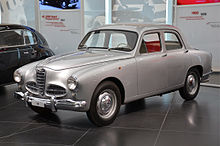
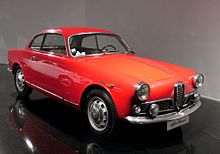
However, the market for the expensive pre-war designs was very small. Like other premium manufacturers, Alfa also turned to the production of mass-produced cars for a broader group of buyers. In 1950 the Alfa Romeo 1900 appeared , at the beginning of 1954 the even smaller and cheaper Giulietta and in mid-1962 the Giulia, produced in the new factory in Arese .
Numerous racing successes and sporty sedans such as the Giulia shaped Alfa Romeo's reputation as a manufacturer of high-quality sports vehicles for the middle class in the 1960s and 1970s. The standard equipment with all-round disc brakes , five-speed gearbox and, above all, the engine with two overhead camshafts and the multiple carburetor system set standards that other manufacturers in this class (such as BMW) only adopted years later. However, the price of a Giulia 1600 was z. B. 1972 also over that of a comparable BMW 2002 , and so the vehicle outside Italy was reserved for a manageable fan base. Since 1961, Alfa Romeo has been cooperating with the Brazilian Fábrica Nacional de Motores , which was completely taken over in 1968. The 2300 model was later produced there, which was temporarily offered in Europe as the Alfa Rio . The Spider , offered from 1966 onwards , was initiated by Max Hoffman , who, as a general importer for the USA, undertook to purchase the first five hundred copies. The sporty model quickly achieved cult status. In the 1960s, Alfa Romeo cooperated with Renault to exchange patents. In Germany, the vehicles were sold through the NSU dealer network, but Alfa’s condition was that cheap motorcycles could no longer be offered for sale in the showrooms. Later on, the company's own Alfa Romeo Vertriebsgesellschaft mbH was founded in Frankfurt-Griesheim.
The Alfasud compact car was presented at the end of 1971 . The Alfasud also marked a technical turning point for Alfa Romeo: It was the manufacturer's first front-wheel drive passenger car . At the same time as the introduction of the Alfasud, Alfa Romeo made use of its experience with the transaxle design and introduced it to the entire middle class from spring 1972 with the Alfetta . At the end of the 1970s, Porsche also brought out the 924 and 928 models with this concept.
As a state company, Alfa Romeo had to bow to political demands again and again. A special factory was built for the Alfasud in the south of Italy, in Pomigliano d'Arco near Naples. Until then, all plants were located in northern Italy. The only purpose was to fight unemployment there. Manufacturing in the plant had dire economic consequences for Alfa Romeo. Productivity was low, so that the equivalent of around 1,000 marks was paid for each car produced. Alfa Romeo slipped into the red in 1973, one year after production of the Alfasud began. In total, the new plant in the structurally weak region has been hit 700 times in 13 years, so an average of one strike per week. A closure of the plant was politically unsustainable. The manufacturing quality of the Alfasud was subject to fluctuations and did not reach the level of the manufacturer. As a reaction to the debacle, Alfa Romeo began manufacturing the Arna in the plant from the summer of 1983 , consisting of the body of the Nissan Cherry and the drive unit of the Alfasud. Only later, under Fiat management, was it possible to operate the plant in southern Italy efficiently and profitably.
Since the mid-1970s, the design of Alfa’s high-volume models became increasingly polarized. Ermanno Cressoni , who took over the management of the Centro Stile Alfa Romeo in 1975 , relied on the wedge shape and broken lines with his formal language called La Linea . The first car to follow this design concept was the Nuova Giulietta , introduced in 1977 , which was widely criticized. The compact Alfasud successor, the Alfa 33 and the Alfa 75 , which replaced the Giulietta, also implemented La Linea . With the introduction of the Model 33 in 1983 and the renaming of the station wagon in 1988 to " Sportwagon " (later also used for 156 and 159), Alfa Romeo is considered to be the founder of the trend towards sporty " lifestyle station wagons ", which the image of the station wagon as should replace sedate "packhorse" sustainably.
Like almost all vehicle manufacturers, Alfa Romeo was also hit by the oil crisis, one reaction was the offer of diesel vehicles from 1978. In 1986 the Alfa Romeo factories were only under half full.
The Fiat era (since 1986)
In the 1980s, the Italian state decided to privatize its 600 industrial holdings, which until then had been grouped under the state holding IRI . Romano Prodi (from the IRI) and Fabiano Fabiano (from the subsidiary Finmeccanica) agreed that Alfa Romeo could no longer have survived as a sole proprietorship and offered it to auto groups for sale, Ford and Fiat applied. In November 1986 the sale to the Fiat group was announced, which first incorporated Lancia before Alfa Romeo and then renamed the company Alfa-Lancia Industriale SpA , which was then formally taken over by Fiat Auto SpA .
The takeover by Fiat meant a takeover of know-how from the group and an increase in quality. However, many Alfisti consider the Alfa 75 (published in mid-1985 for the company's 75th anniversary) as the “last real Alfa Romeo”, and the state-owned company was actually dependent on cooperation, so the 164 , which appeared in autumn 1987, was already planned before Fiat Alfa took over. The 164 was the first large front-wheel drive Alfa (from the "Nord" production line) , and its platform was jointly developed with Fiat (Croma) , Lancia (Thema) and Saab (9000) . The symbol of the group-internal cooperation was the model 155 presented in early 1992 , which had the classic four-cylinder Alfa engines with two overhead camshafts and now with TwinSpark , but its exterior design was related to the Fiat Tempra . In 1993 Alfa Romeo withdrew from the USA.
In the case of the Alfa 33 successors 145 and 146 presented in the summer of 1994, the boxer engines already known from the Alfasud disappeared at the end of 1996 and the focus was now on the in-line four-cylinder engines and, for the 2.0-liter 16V units, on Fiat engines. The V6 engines built since the Alfa 6 (1979–1986) in various displacement versions (2.5, 3.0 and 3.2 l) were largely replaced in April 2005 by new V6 direct injection engines developed together with GM.
In autumn 1997 a new design line was introduced with the Alfa 156 , which borrowed subtle borrowings from the brand history, but also shaped the vehicle design in general. The high belt line, the coupé character of the sedans, aluminum door handles in the front and concealed rear and the martial front are elements that can still be found on models from many manufacturers to this day. The innovations went back to a young generation of in-house designers, including Walter de Silva and Andreas Zapatinas . The station wagon of the 156 (traditionally known as the SPORT WAGON ) was the first to have a sloping rear, which also gave the car an elegant coupé line, a feature that characterizes all so-called lifestyle station wagons today. In the 156, a common rail turbodiesel engine was used in a series vehicle for the first time.
The Fiat group, to which Alfa Romeo belongs, slipped into the red in 2001 and lost three quarters of its value within a short period of time. Alfa Romeo's administration was relocated to Turin, the headquarters of Fiat. In 2003, production at the Arese plant was discontinued. The Centro Stile Alfa Romeo stayed in Arese until 2009 and was then also relocated to Turin, where it has since operated as a department of the so-called Officina 83 , the superordinate design center of the Fiat Group.
From the cooperation between the parent company and General Motors, Alfa Romeo used the new GM / Fiat Premium platform , on which the 159 mid-range , the Brera Coupé and the Spider were built from summer 2005 . These did not meet the expectations of the brand's European-oriented target group.
Streamlining of the model range and realignment
Alfa Romeo has been a public company again since 2007. Under the leadership of Sergio Marchionne , CEO of the Fiat Group since 2004, the brand's portfolio was significantly reduced from mid-2010. The production of Alfa GT , 159 (incl. Sportwagon), Brera and Spider was discontinued and the inventory was sold. Sales slumped to 68,000 units sold in 2014. At the same time, the sister brand and former competitor Lancia was taken off the market with the exception of the Ypsilon .
The brand returned to the USA and Canada with the Alfa Romeo 8C Competizione sports car, which was built in limited numbers .
Alfa Romeo's strategy in the FCA group is not clear. It was announced that the brand would be reoriented globally and established in the premium segment. For the company's 105th anniversary on June 24, 2015, a modernized logo was presented. At the same time, Alfa Romeo presented the new Giulia to the press , which was then introduced in May 2016. Seven more models should follow by 2018 and sales increased significantly. By the end of 2018, only one of the announced models had been presented and delivered.
The current model range (as of 2020) consists of the compact car Giulietta , the mid-range car Giulia and the SUV Stelvio .
Alfa Romeo Giulietta (since 2010)
Alfa Romeo 4C (2013-2019)
Alfa Romeo Giulia (since 2015)
Alfa Romeo Stelvio (since 2016)
Trucks, buses, aircraft engines
In 1930 Alfa Romeo introduced a light truck, but also turned to the construction of heavy trucks based on Büssing designs. During the Second World War , Alfa Romeo mainly built trucks for the Italian army and later also for the German armed forces .
The production of commercial vehicles continued after the war, even if the sales figures were never very high compared to the competition. Various light truck models have been developed in cooperation with Fiat and Saviem since the 1960s. Heavy truck production ended in 1967. In Brazil , the heavy trucks were built under the brand name FNM until 1988 . FNM then became part of the Iveco group of the Fiat group. Until the 1990s, the Fiat Ducato and Iveco Daily vans were also sold under the brand name Alfa Romeo.
Another mainstay of the company was the production of trolleybuses . Alfa Romeo trolleybuses drove in many cities in Italy and in some cases worldwide, of which a total of three new model series appeared by around 1972. In 1944 the Berliner Verkehrsbetriebe ordered three Alfa Romeo trolleybuses, but the follow-up order (1945–47) went to war-damaged Berlin companies for political reasons.
In addition, the company was already building aircraft engines during the First World War and increasingly since the 1930s . In addition to various smaller engines, it was above all the RA.1000 RC 41-I Monsone , a licensed version of the Daimler-Benz DB 601 , with which Italy was able to build powerful fighter planes .
technology
In addition to design, Alfa Romeo has traditionally always focused on technology. As early as 1913, three years after the company was founded, Alfa Romeo engineers developed a high-performance engine for motorsport with two overhead camshafts, four valves per cylinder, roof-shaped combustion chambers and double ignition per cylinder. For example, the 6C models in the 1930s received double valve springs. In the 8C models, aluminum cylinder heads were used for the first time in the world. In the four-cylinder engine of the 1900 TI, two double carburettors increase output for the first time. In 1935, Prof. Ferraguti and A. Agostini fitted an Alfa-Romeo 1750 with a charcoal gas generator and allowed the car to take part in the 1000-mile race.
Five-speed transmissions have been offered in series vehicles since 1958. The GTA gets in the 1960s -Jahren a lightweight body, passed all of whose non-structural parts made of aluminum. The transaxle design was used as standard in the mid-range Alfetta from 1972 . Different all-wheel drive systems have been offered for the Alfa 33 since 1983 . In the same year, Alfa Romeo introduced variable valve control in series, which was the first time a phase adjuster was used for the intake valves (here in a two-liter, four-cylinder engine). In 1997, Alfa Romeo was the first manufacturer ever to present common rail technology for direct injection in diesel cars with the 156 JTD . Gasoline direct injection is now also available in the JTS. As an option today, as in Formula 1, you can change gears using the Selespeed gearshift.
Since 2009 Alfa Romeo has offered the world's first fully variable intake valve control in the MiTo under the name MultiAir . There is no intake camshaft here, the intake valves are electro-hydraulically controlled for each cylinder and, if necessary, several times per cycle. The valve lift and the valve opening time are variable.
Motorsport

Alfa began building racing cars as early as 1913. The 1920s and especially the 1930s were the first great heyday for Alfa Romeo in motorsport. In 1950 they entered the newly founded Formula 1 world championship and immediately became world champion with Giuseppe Farina and the following year with Juan Manuel Fangio . In the 1960s, the motorsport activities were outsourced under the name Autodelta . The touring car racing was then the big focus. Excellent work has been done for nearly two decades and a very proud number of victories achieved. From 1979 to 1985 Alfa Romeo was again represented in Formula 1, but could no longer build on previous successes.
From the 2019 Formula 1 season , the former Sauber F1 Team will be at the start as Alfa Romeo Racing . Thus, the team name Alfa Romeo returns to the premier class after 34 years.
brand
logo
Alfa Romeo combines the coat of arms of the city and the Duchy of Milan in its logo :
The two-part trademark has remained almost unchanged since its creation. In the left half it shows a red cross on a white background, in the right half a snake with a dragon's head and a crown giving birth to a child, the biscione . The left representation corresponds to the city arms of Milan, which reminds of the cross of Christ and unites the colors of the citizens (red) and the peasants (white). It became the official city coat of arms towards the end of the 12th century. The right part was added later at the instigation of a member of the then most powerful family in Milan, the Visconti . At the end of the 13th century, its head, Matteo Visconti , instructed a town clerk to record an incident that was supposed to have taken place in 1111. According to this, a Visconti named Ottone had killed a Saracen prince at the gates of Rome during a crusade and took his coat of arms, which showed the snake giving birth to a child from its mouth. It is thanks to Matteo Visconti that this depiction became part of the Milanese city arms.
When Alfas was founded in 1910, the city arms of Milan were simply adopted as a trademark with the addition of ALFA MILANO. In 1919 this was changed to ALFA-ROMEO MILANO. Until the end of the war in 1945, the Savoy coat of arms was also featured on the trademark in the form of two symbolized boatmen's knots. When Alfa won its first world title in 1925, a laurel wreath was added around the mark out of pride. After the Second World War, the two, sometimes even three (then a knot replaced the city name), Savoy knots disappeared. Until 1972, the city name could be seen on the emblems, and Alfa Romeo was spelled with a hyphen. Then the name MILANO was dropped, because Alfa Romeo now also built cars outside of Milan, for example in Pomigliano d'Arco near Naples in southern Italy, where the Alfasud was initially made.
In June 2015, for the company's 105th anniversary, a logo, which was revised for the first time since 1972, was presented to accompany the planned globalization of the brand. The snake has been highlighted, the division in two removed.
Grille
Like other brands, Alfa Romeo has its very own shape for the radiator grille . At Alfa Romeo it is the so-called Scudetto ('Schildchen', from scudo ' Schild '). This form of a narrow, deeply drawn-down radiator grille that tapers to a point was created in the 1930s. In addition, the vehicle registration number is attached outside the center of the vehicle and offset towards the center of the lane. So it doesn't disturb the appearance of the Scudetto and underlines the dynamic design of the vehicle. From the 1950s onwards, Alfa Romeo added two horizontal air inlets to the pontoon bodies, which are called "baffi" (mustache). In the course of the 1960s, the Scudetto was reduced to a small decorative frame on the actual radiator grille on some models. With the Alfa Romeo 156 , Alfa Romeo took up the arrangement of the 1950s again in 1997, which is still cultivated as a brand-defining design element today.
Rosso Alfa
The color red is now considered the traditional color of Alfa Romeo and Italian cars in general. It is often reported that in the early days of international motor racing, red was the prescribed color for Italy. This is a legend, however, because the assignment of colors to differentiate between nations was just a special feature of the Gordon Bennett Cup , which was held between 1900 and 1905. Italy, which was represented by Fiat , was not assigned red, but black. This is because red was already used as a country color by the United States . As early as 1906, before Alfa Romeo was founded, races were only held as manufacturers' competitions. From then on, the choice of color could be decided individually. The tradition of using red, which developed at Alfa Romeo especially from the 1920s, can be understood as an homage to the origins of racing.
Rosso Alfa , the red of Alfa Romeo, was browner before World War II than it is today. The current color has been unchanged for decades. The now popular Ferrari red, known as Rosso Corsa (“racing red”), is a few shades lighter than the Alfa red.
Nomenclature of the models
It is not that easy to understand the model names of Alfa Romeo. As a rule, Alfa Romeo does not use a model name across several model generations. Many epithets or internal names were later adopted as regular model names.
From the end of the 1920s to the end of the Second World War, all Alfa Romeos not only intended for racing were designated with the abbreviations 6C or 8C and their cubic capacity. 6C stands for six-cylinder, 8C for eight-cylinder.
The following models were either referred to only with their displacement or with their own names. With the Coupé based on the Alfa Romeo Giulia , Alfa Romeo even switched between the two concepts, so that the name of the designer Bertone has become a synonym for this model. Designations according to the cubic capacity were only continued until the mid-1970s.
Until the 1970s, four-door sedans were given the nickname "Berlina", until the 1980s two-door coupés were given the nickname "Sprint" and station wagons were nicknamed "Giardinetta". Since then, station wagons have been nicknamed " Sportwagon ". The term "Spider" for convertibles was initially just an epithet, but became an independent model name at the end of the 1960s and is now used again as an epithet. The earlier suffixes “GT” and “GTV” are now independent model names.
In the early 1980s, all new models were named with a two-digit number preceded by “Alfa”. Since the late 1980s, the number has been three-digit, with the number 1 in the place of the highest value, followed by a number for the vehicle class and a number that increases with the model generations. 14x stands for the compact class, 15x for the middle class and 16x for the upper middle class. However, no model series are currently offered that are subject to this system. Five years after the turn of the millennium, a start was made to assign separate model names again.
The overview is made even more difficult by the fact that Alfa Romeo often names production vehicles after successful racing cars. The term “Alfetta” can mean the Alfa Romeo Alfetta sedan or the Alfa Romeo 159 “Alfetta” racing car . With the designation "Alfa 159" the same racing car or the sedan Alfa Romeo 159 . The term “Alfa 33” can refer to the compact car Alfa Romeo 33 as well as the racing and sports car Alfa Romeo 33 . With the designation "Alfa 8C" an Alfa Romeo 8C Competizione / Spider or an Alfa Romeo 8C 2300/2900 .
Alfa Romeo uses the letter Q to designate variants, Q2 denotes a limited slip differential and Q4 denotes all-wheel drive. Q4 was also the model name of the all-wheel drive variant of the Alfa Romeo 155 or 156. The VW Group later also picked up the letter Q for its Audi brand and secured the remaining single-digit numbers. For a long time, Alfa Romeo refused to sell the two brand names Q2 and Q4. It was not until January 2016 that an agreement was reached between Audi AG and FCA, which will henceforth hold the naming rights for all models from Q1 to Q9 . However, the designation Q2 may still be used for the electronic limited-slip differential by FCA.
Alfisti
A 1967 edition of Spiegel said: “Alfa-Romeo does not sell prestige. An Alfa driver brings enough of it himself. ”Drivers and fans of the vehicles often have a great affinity for the brand and then refer to themselves as Alfisti (plural of Alfista ). The letter combination “AR” is customary as a desired identifier, and since 2003 (when it was also released in Germany) “QV” (for Quadrifoglio Verde , the green clover leaf a symbol from Alfa Romeo's motorsport history) and “MI” (for Milano). The shamrock, like the biscione, the snake from the coat of arms logo, is also used by enthusiasts as a symbol of the brand.
Production facilities
The car production began in the founding plant in Portello near Milan , in 1961 the plant in Arese near Milan and in 1969 the plant in Pomigliano d'Arco near Naples were added. From 1984 to 1986 the Alfa Romeo Arna (a joint product with Nissan ) was also assembled in Pratola Serra ( Avellino province ). After Alfa production ceased with the Alfa Romeo 159 at the Pomigliano d'Arco plant (where the third generation of the Fiat Panda rolls off the production line instead ), Fiat Group Automobiles SpA has been manufacturing the MiTo at the Mirafiori plant in Turin since 2008 , the Alfa Romeo Giulietta (Type 940) and Giulia (Type 952) in Cassino in the Lazio region .
In addition, such well-known design companies as Bertone and Pininfarina have built cars for Alfa Romeo. Alfa-Romeo foreign production facilities were in South Africa ( Alfa Romeo South Africa ) and Brazil . Vehicles abroad are also manufactured by external manufacturers from CKD kits.
Alfa Romeo in the film
Alfa Romeo vehicles are an important prop in numerous films , especially action films and crime novels. In the spirit of typical owners, they stand for a rebellious unconventional way, for example in Der Scoundrel (original title: Docteur Popaul ) with Jean-Paul Belmondo in the lead role, where as a young doctor he mounts an iron grille on his Alfa and with the car the Citroën 2CV smashed his unloved narrow-minded brother-in-law. In Italian crime films, the engine performance of the vehicles is more in the foreground, Carabinieri almost always chase the criminals in fast Alfas. To keep the tension going, the gangsters like to use an Alfa.
A Giulietta Sprint is a central point of the plot in the 1970 film The Things of Life with Michel Piccoli and Romy Schneider . Probably the most famous appearance of Alfas found in 1967 in the film The Graduate (Engl. The Graduate ) with Dustin Hoffman instead. A red Alfa Spider is therefore still often referred to in advertisements in the USA as "The Graduate".
Even James Bond used in the film Octopussy an Alfa Romeo, more specifically a GTV6 . In this 1983 film with Roger Moore , he is followed by two BMW 525i patrol cars and a BMW police motorcycle in a scene that was filmed at the AVUS in Berlin . In the film Quantum of Solace , James Bond is chased by two Alfa 159s in his Aston Martin DBS .
Other film appearances: In Bobby Deerfield 1977, Al Pacino plays a racing driver who privately drives a GTV 4. In the film adaptation of Frederick Forsyth's bestseller The Jackal , the nameless killer drives a white Alfa Romeo Giulietta Spider. In the film Der Eisbär the police drive a silver Alfa 156 2.0 TS, in the final scene an Alfa Giulia Nuova has a longer appearance.
On television is a red Bertone ( Giulia Sprint GT ) in the series of Bayerischer Rundfunk Irgendwie und Sowieso with Ottfried Fischer , Elmar Wepper and others. a became known. This series takes place in the Upper Bavarian province in 1968/69, and although it wasn't actually on the market as a Glatthauber (facelift model) at that time, it is one of the vehicles that are mainly used. Robert Giggenbach alias Efendi could be seen with this vehicle in the series - often very sporty with it. A total of two vehicles were used for the shoot, on closer inspection you can see the differences.
In the television crime series Ein Fall für Zwei , which has had exactly 300 episodes since 1981, the main actor Claus Theo Gärtner , who plays the role of the private detective Josef Matula, mostly uses an Alfa Romeo. Before that, he drove Alfa Romeo privately and saw the brand as suitable to represent the role. Alfa Romeo later made the vehicles available for the shoot. Due to the long running time of the series, the models change over time. However, Audi models were also used here for a short period of time. In his spare time, Claus Theo Gärtner sometimes races with historical Alfas. Alfa Romeos were used in the television series Commissioner Rex . At the beginning Tobias Moretti drove a 155 , later Gedeon Burkhard drove a 166 . In the new episodes, Kaspar Capparoni drives a 159 Sportwagon .
Models
Passenger cars
| Timeline of Alfa Romeo models from 1945 to today | ||||||||||||||||||||||||||||||||||||||||||||||||||||||||||||||||||||||||||||
|---|---|---|---|---|---|---|---|---|---|---|---|---|---|---|---|---|---|---|---|---|---|---|---|---|---|---|---|---|---|---|---|---|---|---|---|---|---|---|---|---|---|---|---|---|---|---|---|---|---|---|---|---|---|---|---|---|---|---|---|---|---|---|---|---|---|---|---|---|---|---|---|---|---|---|---|---|
| Type | Independent until 1933, then state-owned | from 1986 part of Fiat | ||||||||||||||||||||||||||||||||||||||||||||||||||||||||||||||||||||||||||
| 1940s | 1950s | 1960s | 1970s | 1980s | 1990s | 2000s | 2010s | 2020s | ||||||||||||||||||||||||||||||||||||||||||||||||||||||||||||||||||||
| 5 | 6th | 7th | 8th | 9 | 0 | 1 | 2 | 3 | 4th | 5 | 6th | 7th | 8th | 9 | 0 | 1 | 2 | 3 | 4th | 5 | 6th | 7th | 8th | 9 | 0 | 1 | 2 | 3 | 4th | 5 | 6th | 7th | 8th | 9 | 0 | 1 | 2 | 3 | 4th | 5 | 6th | 7th | 8th | 9 | 0 | 1 | 2 | 3 | 4th | 5 | 6th | 7th | 8th | 9 | 0 | 1 | 2 | 3 | 4th | 5 | 6th | 7th | 8th | 9 | 0 | 1 | 2 | 3 | 4th | 5 | 6th | 7th | 8th | 9 | 0 | |
| Small car | MiTo (955) | |||||||||||||||||||||||||||||||||||||||||||||||||||||||||||||||||||||||||||
| Compact class | Arna | |||||||||||||||||||||||||||||||||||||||||||||||||||||||||||||||||||||||||||
| Alfasud | 33 | 145 , 146 (930) | 147 (937) | Giulietta (940) | ||||||||||||||||||||||||||||||||||||||||||||||||||||||||||||||||||||||||
| Middle class | Giulietta Berlina | Giulia | Giulietta (type 116) | 75 | 155 | 156 (932) | 159 (939) | Giulia (952) | ||||||||||||||||||||||||||||||||||||||||||||||||||||||||||||||||||||
| upper middle class | Alfetta | 90 | 164 | 166 (936) | ||||||||||||||||||||||||||||||||||||||||||||||||||||||||||||||||||||||||
| ... | 6C 2500 | 1900 Berlina | 2000 Berlina | 2600 Berlina | 1750/2000 Berlina | Alfa 6 | ||||||||||||||||||||||||||||||||||||||||||||||||||||||||||||||||||||||
| Coupe | Giulietta Sprint | Giulia Sprint GT | Alfasud Sprint | GT (937) | ||||||||||||||||||||||||||||||||||||||||||||||||||||||||||||||||||||||||
| 1900C sprint / super sprint | 2000 sprint | 2600 sprint | 1750/2000 GT Veloce | Alfetta GT / GTV | GTV (916) | Brera (939) | ||||||||||||||||||||||||||||||||||||||||||||||||||||||||||||||||||||||
| Cabriolet | Giulietta Spider | Giulia Spider | Spider ("Duetto") | Spider (916) | Spider (939) | |||||||||||||||||||||||||||||||||||||||||||||||||||||||||||||||||||||||
| 2000 spider | 2600 spider | |||||||||||||||||||||||||||||||||||||||||||||||||||||||||||||||||||||||||||
| Sports car | Disco Volante | Tipo 33 | Montreal | SZ / RZ | 8C Competizione | 4C | ||||||||||||||||||||||||||||||||||||||||||||||||||||||||||||||||||||||
| Off-road vehicle and SUV | Matta | Stelvio (949) | ||||||||||||||||||||||||||||||||||||||||||||||||||||||||||||||||||||||||||
| Vans | Romeo | F12 / A12 | AR6 | |||||||||||||||||||||||||||||||||||||||||||||||||||||||||||||||||||||||||
| AR8 | ||||||||||||||||||||||||||||||||||||||||||||||||||||||||||||||||||||||||||||
|
|
||||||||||||||||||||||||||||||||||||||||||||||||||||||||||||||||||||||||||||
Earlier models
| construction time | model series | image |
|---|---|---|
| 1910-1911 | 12 HP |

|
| 1910-1913 | 24 HP |

|
| 1911-1913 | 15 HP |

|
| 1913-1922 | 40-60 HP |

|
| 1914-1920 | 15-20 HP |

|
| 1914-1920 | 20-30 HP |

|
| 1921-1922 | 20–30 ES Sport |

|
| 1921-1922 | G1 | |
| 1922-1927 | RL / RM |

|
| 1924-1932 | P1 / P2 / P3 |

|
| 1927-1929 | 6C 1500 |

|
| 1929-1933 | 6C 1750 |

|
| 1931-1934 | 8C 2300 |

|
| 1933-1933 | 6C 1900 |

|
| 1934-1939 | 6C 2300 |

|
| 1937-1939 | 8C 2900 |

|
| 1937-1951 | Alfetta 158/159 |

|
| 1939-1953 | 6C 2500 |

|
| 1950-1959 | 1900 |

|
| 1952-1953 | Disco Volante |

|
| 1952-1954 | Matta |

|
| 1953-1953 | BAT5 (prototype) |

|
| 1954-1954 | BAT7 (prototype) |

|
| 1954-1964 | Giulietta (type 750/101) |

|
| 1955-1955 | BAT9 (prototype) |

|
| 1957-1962 | 2000 |

|
| 1960-1964 | Dauphine license construction |

|
| 1961-1969 | 2600 |

|
| 1962-1988 | Giulia |

|
| 1963-1967 | TZ |

|
| 1965-1971 | GTA |

|
| 1966-1993 | Spider (type 105/115) |

|
| 1967-1973 | Tipo 33 |
|
| 1968-1971 | 1750 |

|
| 1970-1977 | Montreal |

|
| 1971-1976 | 2000 |

|
| 1972-1983 | Alfasud |

|
| 1972-1984 | Alfetta |

|
| 1974-1986 | Alfetta GT / GTV |

|
| 1976-1989 | sprint |

|
| 1977-1985 | Giulietta (type 116) |

|
| 1979-1986 | Alfa 6 |

|
| 1983-1994 | 33 |

|
| 1983-1986 | Arna |

|
| 1984-1987 | 90 |

|
| 1985-1992 | 75 |

|
| 1987-1997 | 164 |

|
| 1989-1993 | SZ / RZ |
|
| 1992-1998 | 155 |

|
| 1994-2001 | 145 |

|
| 1995-2000 | 146 |

|
| 1994-2005 | Spider / GTV (type 916) |

|
| 1997-2007 | 156 / Crosswagon |

|
| 1998-2007 | 166 |

|
| 2000-2010 | 147 |

|
| 2003-2010 | GT |

|
| 2005-2011 | 159 |

|
| 2005-2010 | Brera |

|
| 2006-2010 | Spider (type 939) |

|
| 2007-2010 | 8C Competizione |

|
| 2008-2018 | Mito | |
| 2013-2019 | 4C |

|
Current models
| construction time | model series | image |
|---|---|---|
| since 2010 | Giulietta (type 940) |

|
| since 2016 | Giulia (type 952) |

|
| since 2017 | Stelvio |

|
Off-road vehicle
Trucks
- Alfa Romeo 50
- Alfa Romeo 85
- Alfa Romeo 350
- Alfa Romeo 430
- Alfa Romeo 450
- Alfa Romeo 500
- Alfa Romeo 800
- Alfa Romeo 900
- Alfa Romeo 950
- Alfa Romeo Mille (Alfa Romeo 1000)
- Alfa Romeo AR6 ( Fiat Ducato )
- Alfa Romeo AR8 ( Iveco Daily )
buses
- Alfa Romeo 900
- Alfa Romeo 950
- Alfa Romeo Mille (Alfa Romeo 1000)
- Alfa Romeo F12 (minibus, built from 1967 to 1982, also called Autotuttu)
Trolleybuses
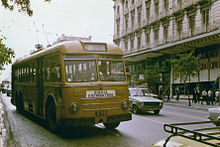
- Alfa Romeo 110AF
- Alfa Romeo 140AF
- Alfa Romeo 900
- Alfa Romeo Mille (Alfa Romeo 1000)
See also
literature
- Jörg Walz: Alfa Romeo type manual - all models from 1910 to today. Heel, Königswinter 2002, ISBN 3-89880-114-4 .
- Matthias Pfannmüller: Alfa Romeo - passenger car since 1945, type compass. Motorbuch Verlag, 2002, ISBN 3-613-02254-0 .
- Alfa Romeo - a fascinating automobile story. Podszun publishing house, 2002, ISBN 3-86133-318-X .
- Alfa Romeo since 1910. Motorbuch Verlag, 2006, ISBN 3-613-02650-3 .
- Joe Benson: Alfa Romeo Automobile - All models from 1946 to the present day. Schrader Verlag, 1993, ISBN 3-921796-08-3 .
- Maurizio Tabucchi: Alfa Romeo - The Complete Type History. Heel, 2000, ISBN 3-89365-837-8 .
- Christian Schön: Alfa Romeo - automobile fascination since 1910. Heel, Königswinter 2010, ISBN 3-86852271-9 .
- Walter Hönscheidt: Alfa-Romeo - passion on wheels. Motorbuch-Verlag, Stuttgart 2015, ISBN 3-613-03795-5 .
Web links
- Alfa Romeo Global
- Alfa Romeo Germany
- Alfa Romeo Austria
- Alfa Romeo Switzerland
- »Alfisti.net« , Internet platform for friends of the Alfa Romeo brand
- Driving reports and practical tests, historical, technical data and photos about Alfa Romeo
Individual evidence
- ↑ Management. Fiat Chrysler Automobiles. Retrieved February 21, 2019 .
- ↑ a b Automobile quarterly. In: Automobile quarterly, Volume 44, Issue 3. Princeton Institute for Historic Research, accessed September 29, 2009 .
- ↑ autoweb.com : " Alfa Romeo celebrates 90 years of success" ( Memento from May 11, 2009 in the Internet Archive )
- ↑ 6 ^ Targa Florio. Retrieved September 26, 2009 (Italian).
- ↑ a b 1915: ALFA diventa Alfa Romeo. Alfa Romeo, accessed September 26, 2009 .
- ↑ Vera Zamagni : The economic history of Italy 1860-1990. P. 221 , accessed August 16, 2009 .
- ↑ Targa Florio 1923. StefanÖrnerdal, accessed September 3, 2009 .
- ↑ Hans Etzrodt: The 1925 Automobile World Championship. Retrieved September 9, 2009 .
- ^ Franco Amatori: Beyond the Firm: Business Groups in International and Historical Perspective. Google, accessed November 17, 2009 .
- ^ Automobile quarterly. In: Automobile quarterly, Volume 44, Issue 3. Princeton Institute for Historic Research, accessed September 29, 2009 .
- ↑ a b Unequal partners . In: Der Spiegel . No. 22 , 1986 ( online ).
- ↑ It was a drama . In: Der Spiegel . No. 11 , 1984 ( online ).
- ↑ a b A picture of a car. In: AUTO BILD 28/2005. July 27, 2005, accessed August 23, 2009 .
- ↑ NN: Poor Julchen. In: Der Spiegel . Issue 46/1981, pp. 274-276.
- ↑ Alfa Romeo 156 came on the market in 1997 with revolutionary Unijet engines. August 7, 2012, accessed April 4, 2015 .
- ↑ Fiat share still very risky. (No longer available online.) Frankfurter Allgemeine Zeitung, May 28, 2004, archived from the original on April 14, 2015 ; Retrieved January 1, 2010 .
- ↑ Georg Kacher: Heart Massage. In: Süddeutsche Zeitung . December 11, 2006, accessed May 26, 2015 .
- ↑ Fiat plans mass layoffs and plant closings across Europe. International Committee of the Fourth International, May 8, 2009, accessed January 1, 2010 .
- ↑ Alfa Romeo severs the load slender link with its Birthplace. June 18, 2009, accessed January 1, 2010 .
- ↑ Caterina Schröder: Fiat Auto SpA becomes Fiat Group Automobiles SpA. (No longer available online.) In: Springer Science + Business Media . January 24, 2007, archived from the original on October 17, 2011 ; Retrieved January 2, 2010 .
- ↑ a b c How the Italian cult brand wants to end its dry spell. Horizon , June 25, 2015, accessed June 25, 2015 .
- ↑ Electrically charged for 66 years. Stuttgarter Zeitung, November 2, 2010, accessed January 8, 2015 .
- ↑ Wolf-Dieter Machgel: Berliner Eisenbahnennahverkehr, p. 156
- ↑ Heraldry; Coat of arms - their origin, meaning and value (by Ottfried Neubecker, ISBN 3-8105-1306-7 )
- ↑ Audi Q2 and Q4 can come: swap deal with FCA. Autophorie.de, January 19, 2016, accessed on March 3, 2016 .
| Timeline of Alfa Romeo models from 1945 to today | ||||||||||||||||||||||||||||||||||||||||||||||||||||||||||||||||||||||||||||
|---|---|---|---|---|---|---|---|---|---|---|---|---|---|---|---|---|---|---|---|---|---|---|---|---|---|---|---|---|---|---|---|---|---|---|---|---|---|---|---|---|---|---|---|---|---|---|---|---|---|---|---|---|---|---|---|---|---|---|---|---|---|---|---|---|---|---|---|---|---|---|---|---|---|---|---|---|
| Type | Independent until 1933, then state-owned | from 1986 part of Fiat | ||||||||||||||||||||||||||||||||||||||||||||||||||||||||||||||||||||||||||
| 1940s | 1950s | 1960s | 1970s | 1980s | 1990s | 2000s | 2010s | 2020s | ||||||||||||||||||||||||||||||||||||||||||||||||||||||||||||||||||||
| 5 | 6th | 7th | 8th | 9 | 0 | 1 | 2 | 3 | 4th | 5 | 6th | 7th | 8th | 9 | 0 | 1 | 2 | 3 | 4th | 5 | 6th | 7th | 8th | 9 | 0 | 1 | 2 | 3 | 4th | 5 | 6th | 7th | 8th | 9 | 0 | 1 | 2 | 3 | 4th | 5 | 6th | 7th | 8th | 9 | 0 | 1 | 2 | 3 | 4th | 5 | 6th | 7th | 8th | 9 | 0 | 1 | 2 | 3 | 4th | 5 | 6th | 7th | 8th | 9 | 0 | 1 | 2 | 3 | 4th | 5 | 6th | 7th | 8th | 9 | 0 | |
| Small car | MiTo (955) | |||||||||||||||||||||||||||||||||||||||||||||||||||||||||||||||||||||||||||
| Compact class | Arna | |||||||||||||||||||||||||||||||||||||||||||||||||||||||||||||||||||||||||||
| Alfasud | 33 | 145 , 146 (930) | 147 (937) | Giulietta (940) | ||||||||||||||||||||||||||||||||||||||||||||||||||||||||||||||||||||||||
| Middle class | Giulietta Berlina | Giulia | Giulietta (type 116) | 75 | 155 | 156 (932) | 159 (939) | Giulia (952) | ||||||||||||||||||||||||||||||||||||||||||||||||||||||||||||||||||||
| upper middle class | Alfetta | 90 | 164 | 166 (936) | ||||||||||||||||||||||||||||||||||||||||||||||||||||||||||||||||||||||||
| ... | 6C 2500 | 1900 Berlina | 2000 Berlina | 2600 Berlina | 1750/2000 Berlina | Alfa 6 | ||||||||||||||||||||||||||||||||||||||||||||||||||||||||||||||||||||||
| Coupe | Giulietta Sprint | Giulia Sprint GT | Alfasud Sprint | GT (937) | ||||||||||||||||||||||||||||||||||||||||||||||||||||||||||||||||||||||||
| 1900C sprint / super sprint | 2000 sprint | 2600 sprint | 1750/2000 GT Veloce | Alfetta GT / GTV | GTV (916) | Brera (939) | ||||||||||||||||||||||||||||||||||||||||||||||||||||||||||||||||||||||
| Cabriolet | Giulietta Spider | Giulia Spider | Spider ("Duetto") | Spider (916) | Spider (939) | |||||||||||||||||||||||||||||||||||||||||||||||||||||||||||||||||||||||
| 2000 spider | 2600 spider | |||||||||||||||||||||||||||||||||||||||||||||||||||||||||||||||||||||||||||
| Sports car | Disco Volante | Tipo 33 | Montreal | SZ / RZ | 8C Competizione | 4C | ||||||||||||||||||||||||||||||||||||||||||||||||||||||||||||||||||||||
| Off-road vehicle and SUV | Matta | Stelvio (949) | ||||||||||||||||||||||||||||||||||||||||||||||||||||||||||||||||||||||||||
| Vans | Romeo | F12 / A12 | AR6 | |||||||||||||||||||||||||||||||||||||||||||||||||||||||||||||||||||||||||
| AR8 | ||||||||||||||||||||||||||||||||||||||||||||||||||||||||||||||||||||||||||||
|
|
||||||||||||||||||||||||||||||||||||||||||||||||||||||||||||||||||||||||||||

